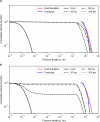Fast boulder fracturing by thermal fatigue detected on stony asteroids
- PMID: 39080275
- PMCID: PMC11289370
- DOI: 10.1038/s41467-024-50145-y
Fast boulder fracturing by thermal fatigue detected on stony asteroids
Abstract
Spacecraft observations revealed that rocks on carbonaceous asteroids, which constitute the most numerous class by composition, can develop millimeter-to-meter-scale fractures due to thermal stresses. However, signatures of this process on the second-most populous group of asteroids, the S-complex, have been poorly constrained. Here, we report observations of boulders' fractures on Dimorphos, which is the moonlet of the S-complex asteroid (65803) Didymos, the target of NASA's Double Asteroid Redirection Test (DART) planetary defense mission. We show that the size-frequency distribution and orientation of the mapped fractures are consistent with formation through thermal fatigue. The fractures' preferential orientation supports that these have originated in situ on Dimorphos boulders and not on Didymos boulders later transferred to Dimorphos. Based on our model of the fracture propagation, we propose that thermal fatigue on rocks exposed on the surface of S-type asteroids can form shallow, horizontally propagating fractures in much shorter timescales (100 kyr) than in the direction normal to the boulder surface (order of Myrs). The presence of boulder fields affected by thermal fracturing on near-Earth asteroid surfaces may contribute to an enhancement in the ejected mass and momentum from kinetic impactors when deflecting asteroids.
© 2024. The Author(s).
Conflict of interest statement
The authors declare no competing interests.
Figures







References
-
- Molaro, J. L., Byrne, S. & Le, J. L. Thermally induced stresses in boulders on airless body surfaces, and implications for rock breakdown. Icarus294, 247–261 (2017).10.1016/j.icarus.2017.03.008 - DOI
-
- Ruesch, O. et al. In situ fragmentation of lunar blocks and implications for impacts and solar-induced thermal stresses. Icarus336, 113431 (2020).10.1016/j.icarus.2019.113431 - DOI
-
- Molaro, J. L., Byrne, S. & Langer, S. A. Grain-scale thermoelastic stresses and spatiotemporal temperature gradients on airless bodies, implications for rock breakdown. J. Geophys. Res. Planets120, 255–277 (2015).10.1002/2014JE004729 - DOI
LinkOut - more resources
Full Text Sources

